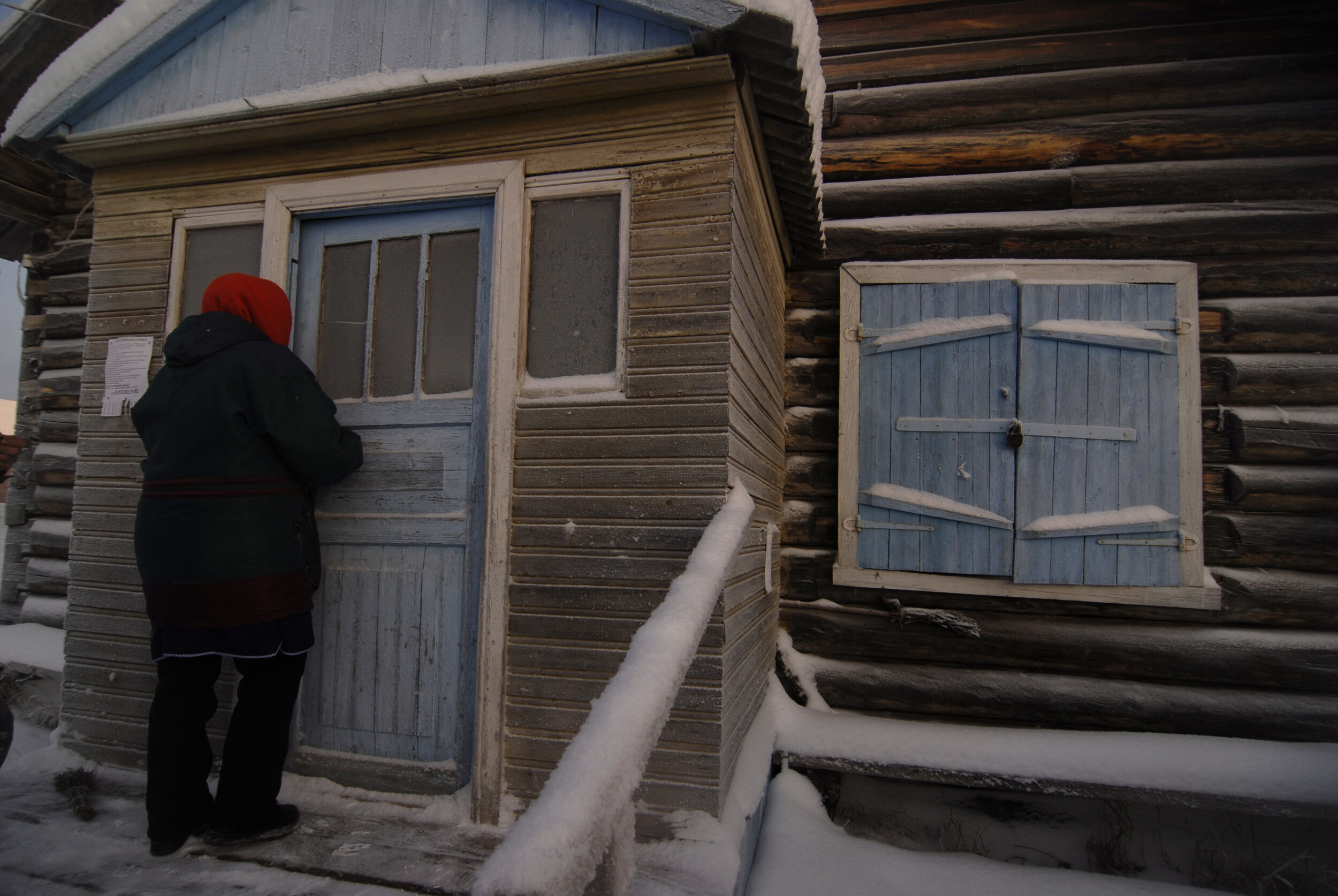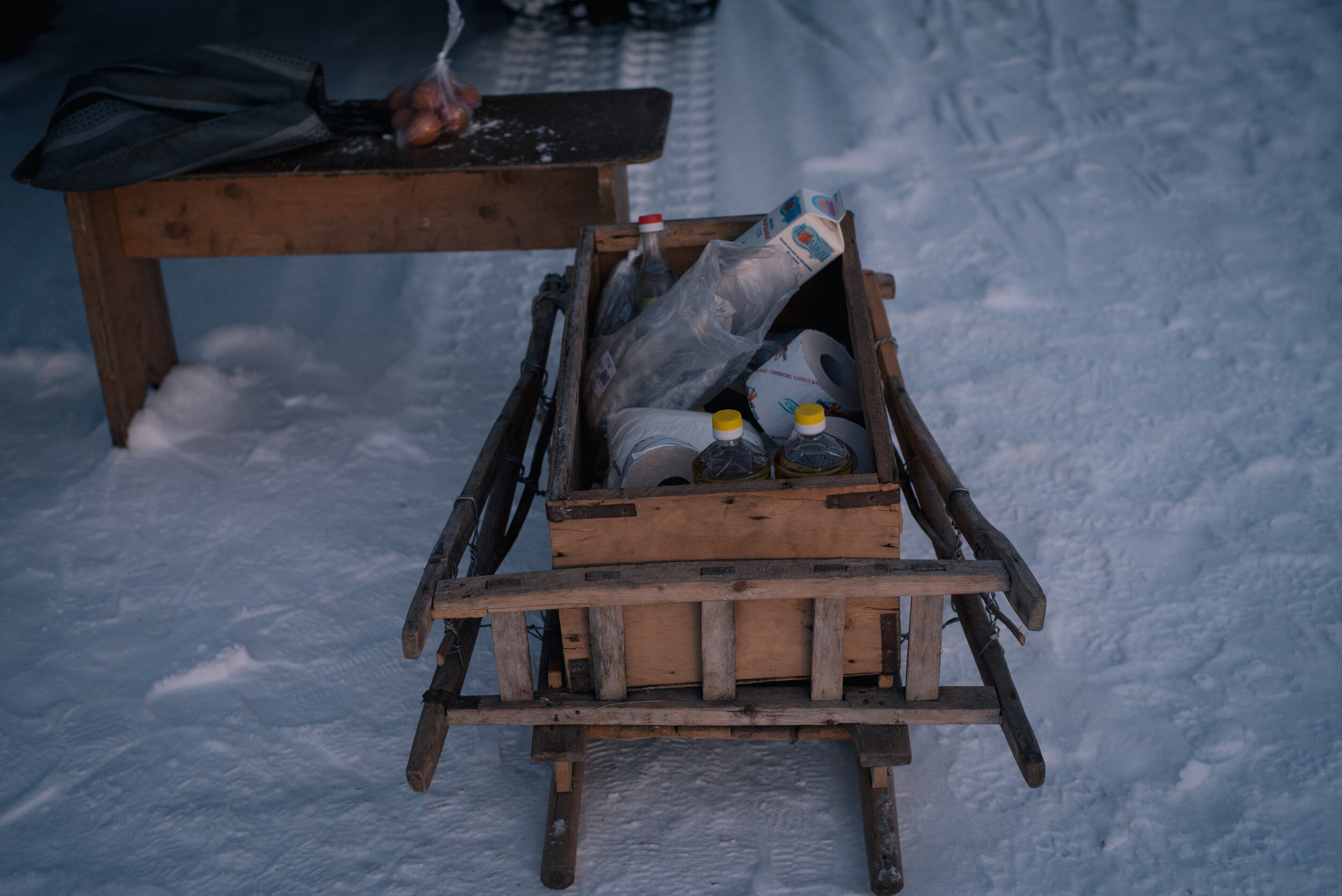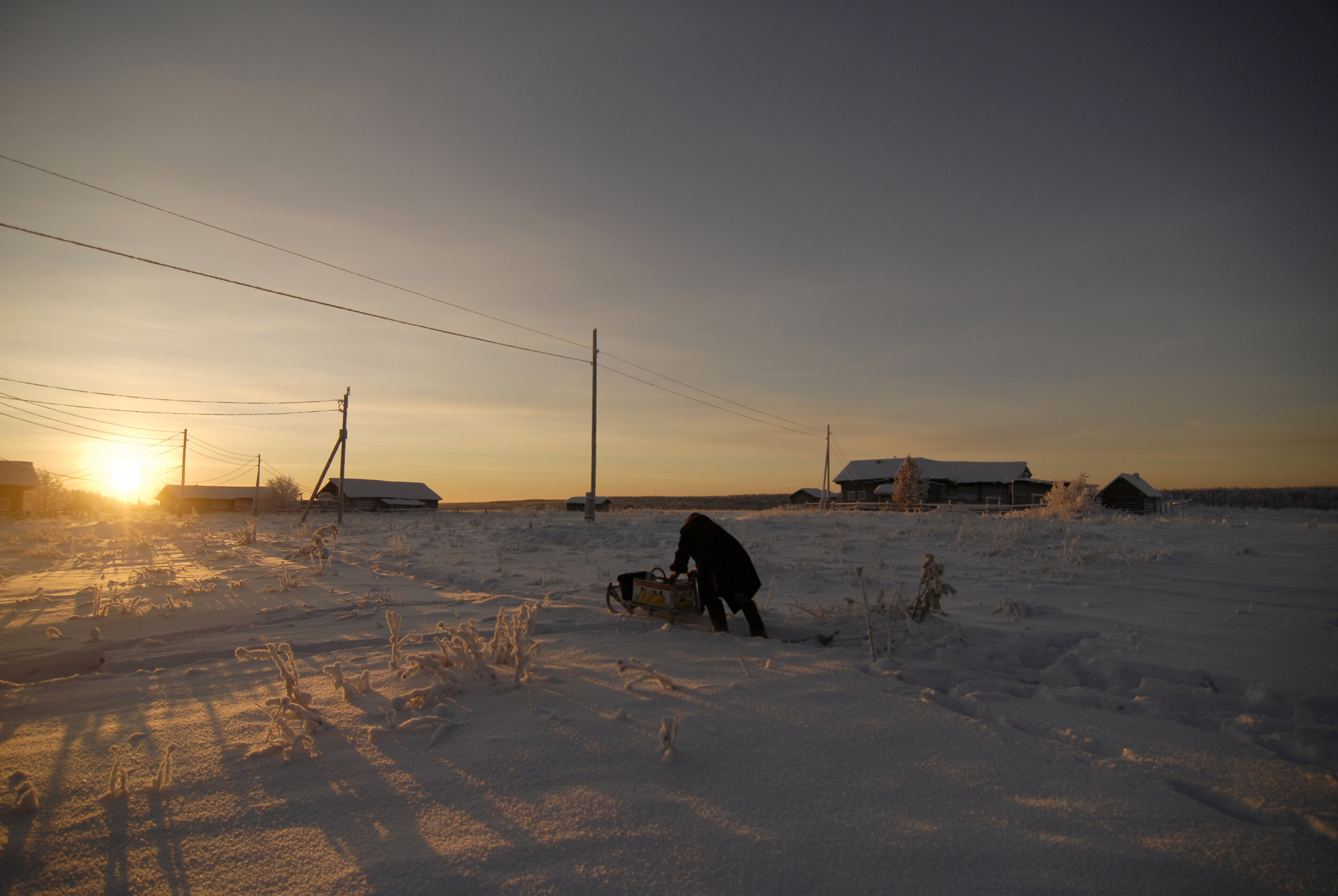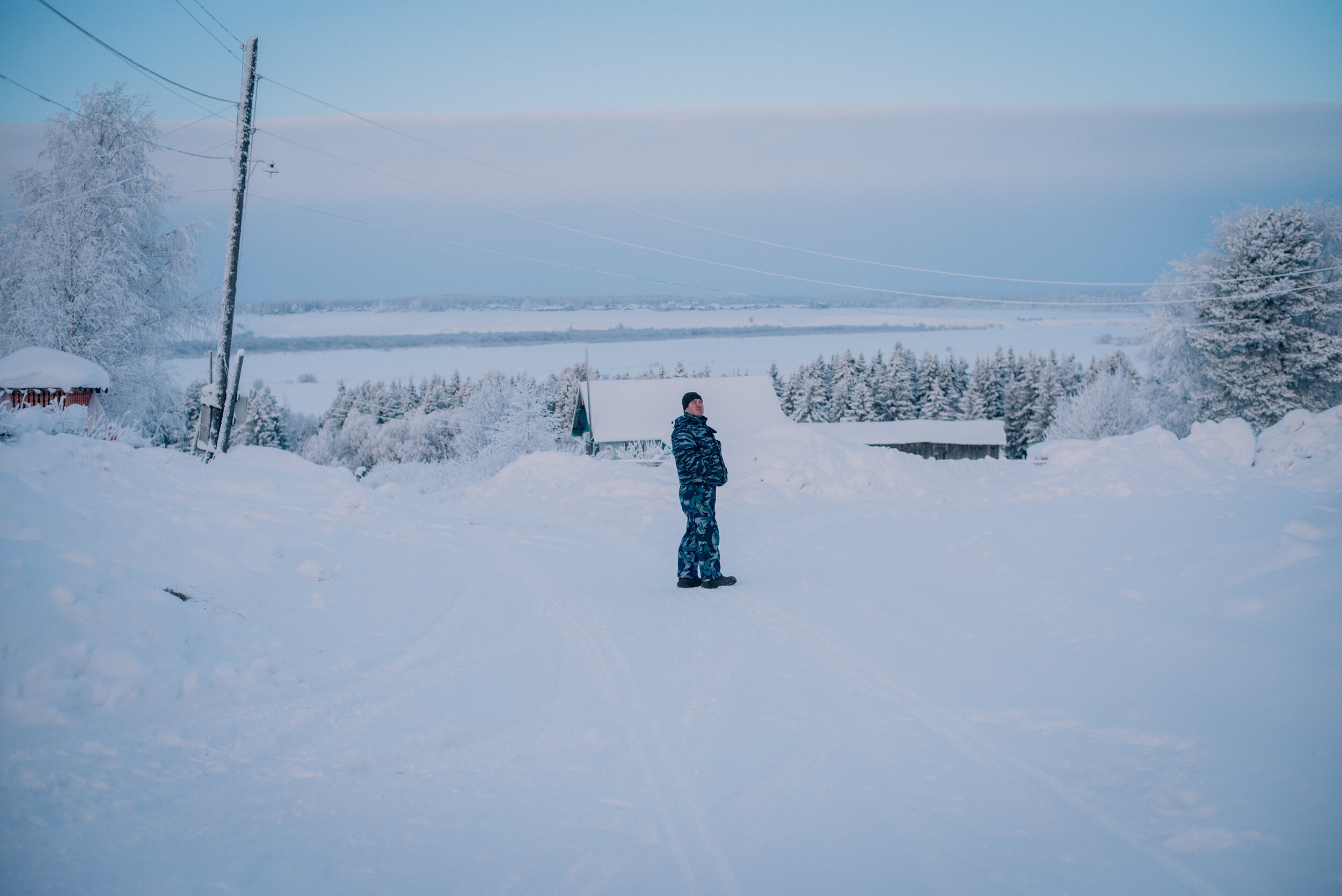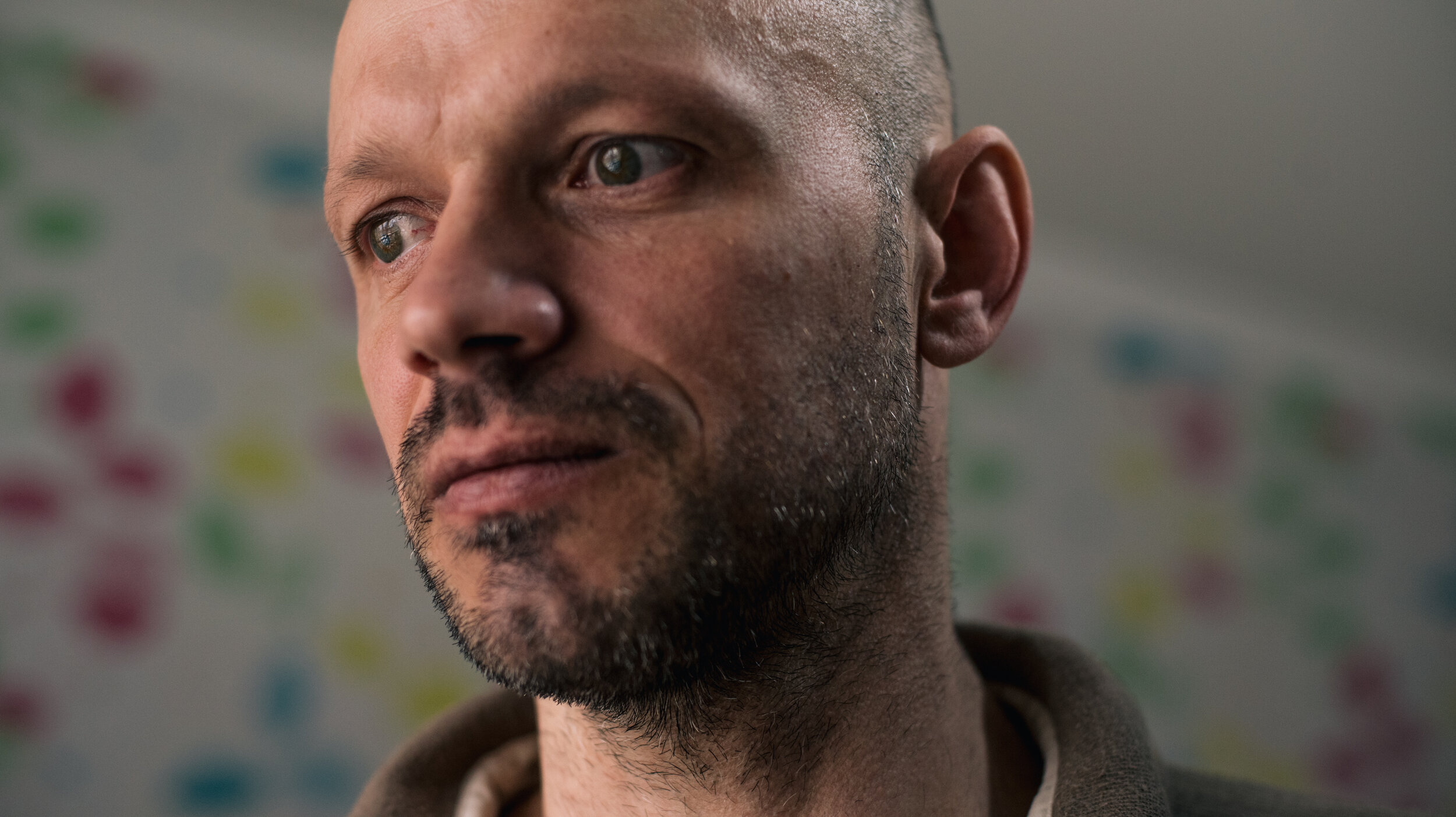
Photography Journal
Biscuits, bread and water of the forgotten villages
How centuries-long history of the Northern Russian villages in Pinega region was coming to an end right before my eyes.
An excerpt from a long-term personal documentary project.
Russia, Arkhangelsk region, Pinega district. Summer of 2008. Pastoral landscapes, endless ancient northern songs, tender and unusual dialect, holidays and fun. That's what my first, spontaneous trip to the northern villages was about.
Something else, impending like a dark cloud on a cloudless sky, forced me to take a closer look at what was happening. Extinction was crawling towards the villages.
I returned the next winter. I saw abandoned houses, entire villages that had lost their inhabitants. People fled the villages lacking jobs and any future to the cities. Centuries long history of the Pinega villages was coming to an end right before my eyes.
Biscuits
“Will you have dinner?” Rimma Petrovna asks, running past me to the kitchen. It's about 11 o'clock in the morning. Half an hour ago the dawn broke. In the silence of a winter morning, her bare steps on the wooden floorboards echo loudly.I wouldn't dare call her an “old woman” or mark her age in any other way. In her youth, this girl used to fly around, and she continues to fly around as much as her health allows her..
Pinega women, especially the elderly, call each other "girls". They never had the chance to get old. They buried their husbands long ago, they need to chop firewood, carry water buckets, heat furnaces, clear snowdrifts, go to the forest, all on their own.
I have no idea when Rimma Petrovna had the time to cook, but from the Russian stove a cast-iron pan with solonina (fried potatoes with pickled mushrooms) shows up, the table is filled with musyonka (flour porridge), jams, pickles, steamed turnip, moistened radish, wilted tea prepared in a French press (“we collected it in the summer with my daughter and lined the entire floor in the house with tea while it was drying” comments Rimma), and then comes the king of the table, a rare product — "Jubilee" biscuits brought by someone from a city. This biscuit box is almost the only item on the table bought for money, all the rest is grown, collected, salted, preserved by Rimma herself. “Take more biscuits, don't hesitate, come on!” — Rimma Petrovna pushes me towards the valuable delicacy.
How in the world has a "Jubilee" biscuit become a luxury product? How has bread become a luxury food? How, after all, in a village located next to Pinega river, has water become a luxury?
2010. Cheshegora village. Grocery store entrance
Bread
I remember this grocery store in Cheshegora. It is now closed for good, but back in 2011 it still opened, one hour a week. Its shelves were dreary, as in USSR of the late eighties. However, the villagers regularly came to this store. After all, they could buy here some bread delivered from across the river!
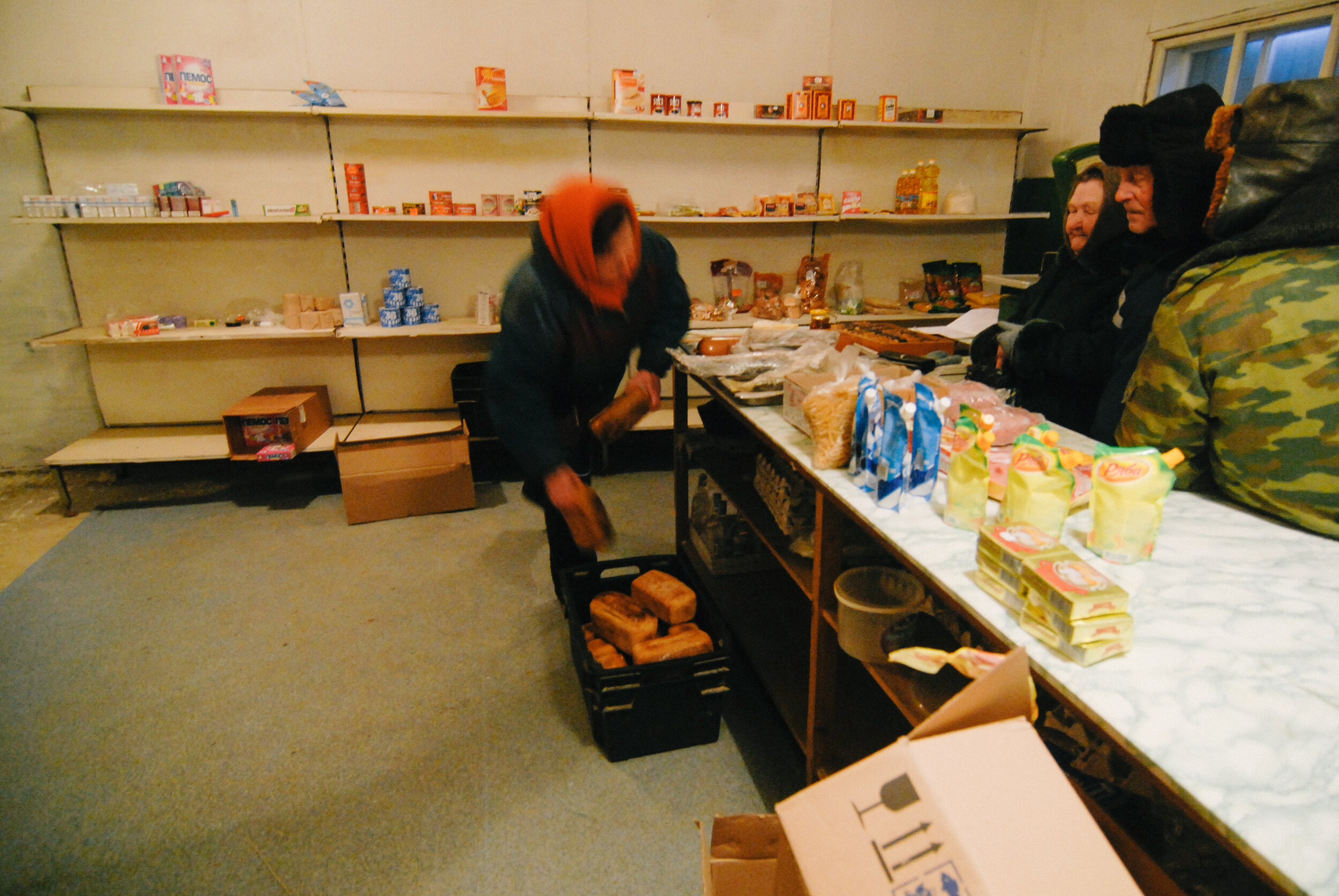
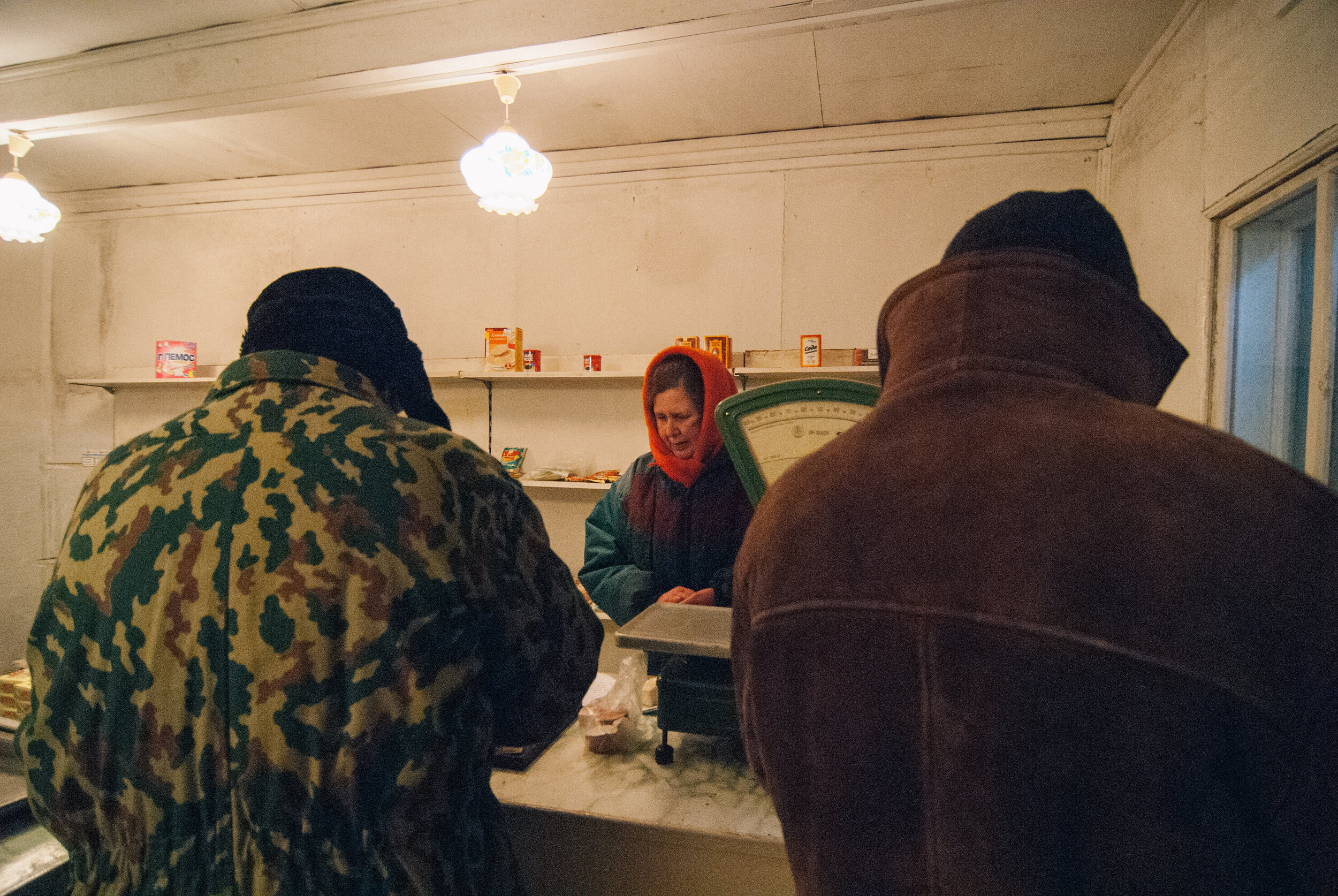
If you didn't show up on time at the grocery to buy food, all you can do is wait for a mobile shop which should arrive on Wednesday, maybe. Or on Thursday.
Rimma Petrovna gets a call from the district center: “Petrovna, we are heading out to you”. It means that the mobile grocery left the town of Karpogory. Petrovna spreads the important news across the village by calling each of six inhabited houses: “The merchants coming!”
2019. Cheshegora village
An hour later, people flock from all corners of the village. There are about ten of them living in Cheshegora, and all are well over sixty. They walk slowly to the village center, where the grocery used to be, and where the last remaining light pole still illuminates a tiny circle around itself at nights. They walk past abandoned huts, dozens of courtyards covered with untouched snow, a shiny red payphone installed recently by the authorities and never used by anyone. They drag handmade sledges, old cradles from baby carriages — whatever one can use to pack the food and bring it home.
You need to buy more, because the “merchants” come only once a week, and they don't come when it storms. Cookies, bread, butter, frozen fish, wine ("wine" is for vodka here), tea, flour, milk, matches, some kind of sausages. What else. Oh, eggs. Well, that's enough. We will last a week.
2011. Cheshegora village. Waiting for a mobile grocery
2019. Cheshegora village. Waiting for a mobile grocery
2019. Cheshegora village. Mobile grocery
It's January. The frost is harsh, -35 degrees Celsius (-31 Fahrenheit). The saleswoman in the back of the grocery truck is bending over a calculator and a till, counting money with her frozen fingers. People line up and cover their faces with mittens and scarves to escape the cold.
A discussion is going on in the line:
- Petrovna, did you call Mishka? Why didn't he show up yet?
- He's drunk, can't walk really.
- What a fool, he gonna drink until he dies.
So, Mishka's left without food for a week.
2011. In the grocery truck heading to Kusogora village
The route of the mobile grocery is fifty kilometres long. The truck stops in five villages which have no groceries. In the village of Kurga lives one person. In the village of Turiya there is one person as well. Shasta has two. Cheshegora has ten. Kusogora is an exception, there are a couple of dozens of residents, and not all of them are pensioners. With the minoral number of clients, the owner of the Karpogory store earns no profit from the mobile shop project. Even taking into account crazy food prices, this looks more like a charity, and no one knows if the goodwill of merchant Viktor Bogdanov will last long.
2019. Mobile grocery near Kurga village
January, 2019. From Turiya village to the highway, there is a kilometer of forest road covered with snow. The only resident of Turiya shows up on skies. He does not want to be photographed.
December, 2010. Kochmogora village
2011. Kochmogora village
The grocery truck doesn't make a stop in Kochmogora anymore: the village is empty.
2010. Shasta village
In Shasta, right next to the highway hunter Nikolai lives with his wife. The rest of this once large village is empty. Thirty years ago, two hundred families lived in Shasta.
The last stop of the mobile grocery in Kusogora village is the longest one. The village is located on a hill high above Pinega river. The truck driver, Nickolay, a hefty good-natured person, walks away from the truck and stares intently across the river, then turns to me. “There it is, my village, Chakola. I come from there. I can even see my house. Ah, but I'm not visiting Chakola anymore. I just stand here and look from afar. It's a pity…”
Water
2019. Cheshegora village. A well
Something's wrong with the water in Cheshegora village. No one knows exactly what happened, but, according to the locals, “feces got into the water”, and for last several years it is unsuitable for drinking.
2019. Cheshegora village. “Water quality check”
Mikhail doesn't believe in the rumors about water. He checks its quality with a nut on a rope. If the nut makes circles as it moves, it's safe to drink it. If the nut goes across, just don't drink.
2019. Cheshegora village. Mikhail
Mikhail was born and spent his childhood in Cheshegora, then he moved across the river to Pyrinem village, and recently retired and returned to Cheshegora. "It's just easier to live here. At least you can get to the district center". Bus service to any of the villages was closed three years ago, and one can only get to Cheshegora by a private car, but Pyrinem is also across the river. There are no roads on that side, and it's much more difficult to get there.
2019. Cheshegora village. Water reserve for a month at Rimma Petrovna's house
Rimma Petrovna and most of her neighbors don't drink from the well. Once a month her grandchildren bring her water in cans. Some villagers get water from Pinega river, but it's quite a walk. The river is about 2 kilometres away from houses, and the banks are high and steep. Everyone invents their own workaround.
As summer comes, preparations for winter begin. First of all, firewood. A woodpile should contain enough firewood for the next two winters at least, that's a rule. Then come berries, mushrooms and herbs - anything that can be forged in the wilderness. Not much can be harvested in a garden: the climate is harsh. People grow potatoes, cabbages and carrots.
Inventing workarounds, surviving, perceiving extreme conditions as the norm has long become a habit and a necessity here. Each winter is a circumnavigation. One needs to prepare seriously to survive it without a loss. How many winters left until the villages will become silent, until forgotten people will leave their houses for good? Not many, I’m afraid.
250 documentary photography assignments. Lessons learned
What the journey of a documentary photographer looks like
In 2019 I hit a milestone in my photographer's career: I've accomplished 250 paid documentary assignments. It took me ten years and half a million frames to get there. I thought it's a decent reason to reflect a little bit on what has been done and what the journey feels like.
A-Ha moment
One day I was on an assignment together with a seasoned fundraiser who uses my pictures in the fundraising campaigns for many years . One phrase she said became the most important insight of all my career: "Do you know that some of your images brought in up to million dollars in donations?" This knowledge struck me. For me, this became a justification of all my breakdowns, doubts, fears, struggles and sleepless nights after emotional shoots. When I decided to become a humanitarian photographer, I wanted my pictures to make a difference for real people, and it turns out, they do.
After a few initial years in "pure" photojournalism at the dawn of my life in photography, I realized that no matter how striking a story published in a regular newspaper or magazine is, it serves an informing or entertaining goal, but almost never becomes a call to action. It's the opposite of humanitarian organizations' media: all their publications are aimed to make people want to do something about the cause. This makes a whole lot of sense for me.
What is the most joyful part?
Being a documentary photographer I don't stage things, so I love when a scene surprises me with natural emotions, colors, lines, spots, rhymes and rhythms. A lot of my photoshoots take place in small and dark flats of the former Soviet Union, where you don't expect any visual surprises. Even in that environment a daily life sometimes gains the potential to be perfectly framed, and a rectangle in front of my viewfinder obtains multiple meanings, multiple layers. When I see this happening, I get high. Probably my heart starts racing.
What's the hardest?
There's a lot of bitterness in being a humanitarian photographer. The hardest photoshoot I ever had so far was in war-torn Ukraine. I saw bombed residential buildings in Mariupol, which is my dad's hometown by the way, I spoke to dozens of uprooted and desperate people, I saw a hospital near Slavyansk caught in a cross-fire with staff and patients inside. I remember taking pictures of this ruined hospital and whispering to myself: "Thank goodness I have a camera, so I can concentrate on composition and exposure..."
Walking into someone's house, seeing terrible living conditions and then leaving is hard. I always think: "I spent there an hour and I'm so depressed, and these people spend there every day of their life!"
Listening to the parents of disabled children is hard, to the level that I consider having healthy children a miracle. I'm scared to have more children now and I have a hard time trying to explain my fear to my wife.
Finding out about passing away those whom I recently photographed is hard.
Running into the stories of social injustice, indifference, neglect is hard.
Sometimes, after a day of a shoot, I feel too lucky, undeservingly lucky.
I always get home heartbroken, nevertheless I always head to each assignment inspired and excited. I know that I'm doing a meaningful job, this lets me stay on top of my breakdowns.
What are the pitfalls?
I think my personal pitfall is my willingness to lift too much weight: when I make stills, film video, conduct an interview and translate it in real-time I often feel overwhelmed. I can't afford failure at any of my tasks, so I allocate all my abilities to make everything done, and then by the evening I reach a hotel like a walking dead.
Pieces of advice
I have set a number of strict rules for myself years ago which up to now were never written down. A lot of them are pretty far from the business of photography itself, but following them saved me more than once as a photographer, business person and human being:
Prior to the shoot get into the mindset of making the best job you've ever done;
Dignity is the key. It's often being said that no frame deserves a photographer's life. For me the same goes for dignity: no frame deserves humbling your subject. In humanitarian photography, we constantly deal with vulnerable people living through their hardest times. You don't want to exploit them and their condition. Even though you know that their tears in the frame will raise money for them.
On one of my first humanitarian photography assignments, I was asked by the local staff to not upset the clients. It was an unusual request. Turned out, before me another photographer visited that place, who intentionally made subjects cry for the sake of a "good picture". Everyone who worked with me knows that I have a dignity rule in place and such a thing would never occur on my visit.
Sometimes it's appropriate to take a picture and sometimes absolutely not. How do you find out? Simply stay human, don't turn yourself into a cynical picture-taking mechanism. After you leave, the subject should feel respected, taken care of, dignified, and not embarrassed, confused and upset.
Listen to your customers. Better don't assume that you know what they are looking for when they send you on an assignment. It's your job to make sure that you are on the same page. Getting into fine details of their requirements will help you understand the overall approach. The stakes are high in humanitarian photography: we are dealing with disaster relief, with helping people who rely heavily on humanitarian assistance;
Find out beforehand everything about the people you're going to meet;
Write a list of equipment to take with you;
Have basic medicines with you at all times. Running nose or a sudden onset of fever in the middle of a shoot day is the worst that can happen. It happened to me a lot, so I have a kit of strong medicines with me wherever I go. I also take a course of multivitamins before I set out to shoot in another corner of the world.
Print out hard copies of all the essential information: contact details in the field, flights, hotels, local emergency numbers;
Secure yourself a local simcard and local cash;
This one is very important: every morning before leaving for a shoot switch on every piece of equipment and make a test. I tend to do myself a favor and take a selfie as a test;
Pay attention to clothes. I'm not good at dressing up fancy, but I do dress appropriately and neat. I need to feel comfortable in my clothes, however. My working day consists of car travels, fast freezing (or sweating) walks with gear on my shoulders, climbing up the stairs, working in hot and choking flats. I don't want to sweat too much and to freeze too much, so proper dressing sometimes turns into a challenge.
Look nice. My supervisor at the American Joint Jewish Distribution Committee (JDC) told me before my very first assignment: "Remember that for those whom you are filming you are the face of JDC, they don't care whether you're a freelancer or a staff member." I've learned this and always keep it in mind. I tend to visit a hairdresser a few days before my assignment trips.
Listen actively, but don't produce any sounds. During a shoot or an interview stay in the moment, put aside all your other thoughts, even when you see your camera falling down from a desk (happened to me), even when something goes wrong with the equipment (happened, too). You don't want to hassle with your camera in front of your subject. Have a backup camera ready, even if it's a smartphone, and just keep rolling.
Backup everything. Coming back to a hotel in the evening as walking dead, I know that there is a mandatory task awaiting me before I fall down senselessly on my bed: copy today's files from the camera to the hard drive and then copy them to another hard drive. If I'm lucky enough to stay in a place with decent WiFi I also upload everything in a cloud. Dozens of people besides myself work hard to make these photo shoots happen, and repeating them is never an option. I keep this in mind.
Don't get lost in your deliverables. It's all about a simple but cohesive and self-explanatory system of files and folders naming. Luckily I established this system from the very beginning, and now I easily find my pictures from ten years ago. When I import the pictures into Lightroom I also assign them with a few keywords, so whenever my clients need me to send them a selection like "Wintertime in Russia" I can provide it with ease. Labeling the best pictures in Lightroom also saves a lot of time in the long run.
Lastly, an extremely important one: Be an accurate business person. That's a whole large topic but essentially stay on top of accounting, contracts and deadlines. Deliver more than expected, better than expected, faster than expected. I use Sprout Studio software for my business routine and exploit my natural passion and curiosity to get the pictures delivered very fast, in some cases even on the day of the shoot (photojournalistic background helps me here).
Overall, regardless of all the hardships of the profession, I'm living my dream. I consciously went into the humanitarian photography field, and I'm aiming to learn more lessons that I promise to share after I'm done with my 500th assignment!
Update:
This article was also published by several online photography magazines:




